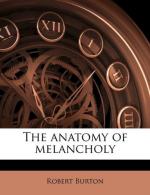some degree, that fame which had lasted near a century;
and the succeeding generation affected indifference
towards an author, who at length was only looked into
by the plunderers of literature, the poachers in obscure
volumes. The plagiarisms of
Tristram Shandy,
so successfully brought to light by
Dr.
Ferriar,
at length drew the attention of the public towards
a writer, who, though then little known, might, without
impeachment of modesty, lay claim to every mark of
respect; and inquiry proved, beyond a doubt, that
the calls of justice had been little attended to by
others, as well as the facetious
Yorick.
Wood observed, more than a century ago, that
several authors had unmercifully stolen matter from
Burton without any acknowledgment. The time,
however, at length arrived, when the merits of the
Anatomy of Melancholy were to receive their
due praise. The book was again sought for and
read, and again it became an applauded performance.
Its excellencies once more stood confessed, in the
increased price which every copy offered for sale
produced; and the increased demand pointed out the
necessity of a new edition. This is now presented
to the public in a manner not disgraceful to the memory
of the author; and the publisher relies with confidence,
that so valuable a repository of amusement and information
will continue to hold the rank to which it has been
restored, firmly supported by its own merit, and safe
from the influence and blight of any future caprices
of fashion. To open its valuable mysteries to
those who have not had the advantage of a classical
education, translations of the countless quotations
from ancient writers which occur in the work, are
now for the first time given, and obsolete orthography
is in all instances modernized.
Account of the author.
Robert Burton was the son of Ralph Burton, of an ancient
and genteel family at Lindley, in Leicestershire,
and was born there on the 8th of February 1576. [1]He
received the first rudiments of learning at the free
school of Sutton Coldfield, in Warwickshire [2]from
whence he was, at the age of seventeen, in the long
vacation, 1593, sent to Brazen Nose College, in the
condition of a commoner, where he made considerable
progress in logic and philosophy. In 1599 he
was elected student of Christ Church, and, for form’s
sake, was put under the tuition of Dr. John Bancroft,
afterwards Bishop of Oxford. In 1614 he was admitted
to the reading of the Sentences, and on the 29th of
November, 1616, had the vicarage of St. Thomas, in
the west suburb of Oxford, conferred on him by the
dean and canons of Christ Church, which, with the
rectory of Segrave, in Leicestershire, given to him
in the year 1636, by George, Lord Berkeley, he kept,
to use the words of the Oxford antiquary, with much
ado to his dying day. He seems to have been first
beneficed at Walsby, in Lincolnshire, through the munificence




